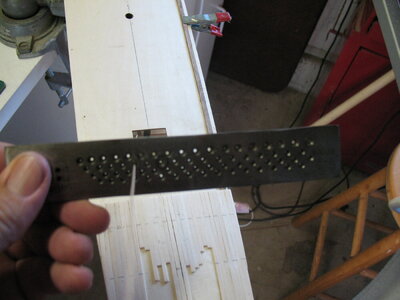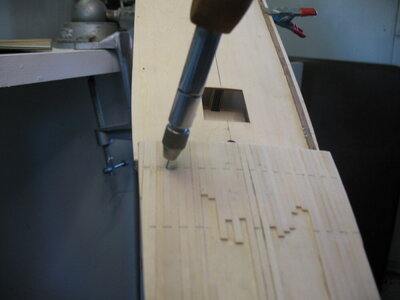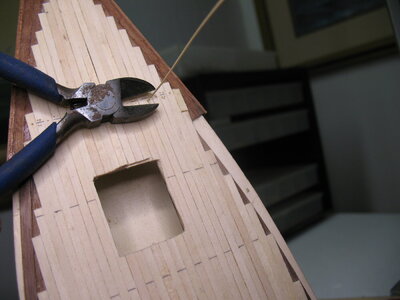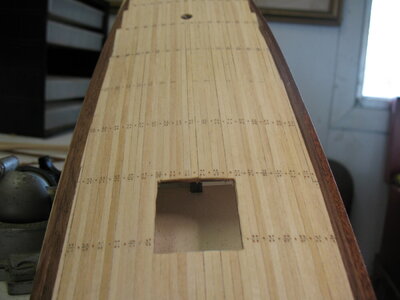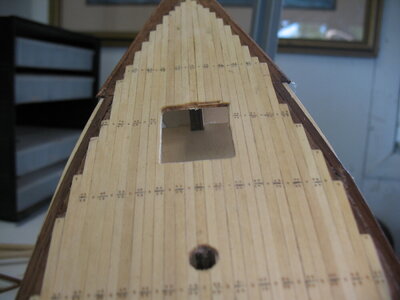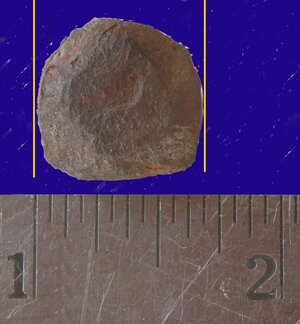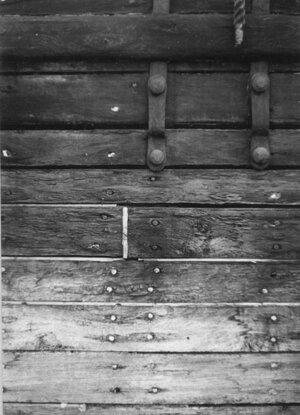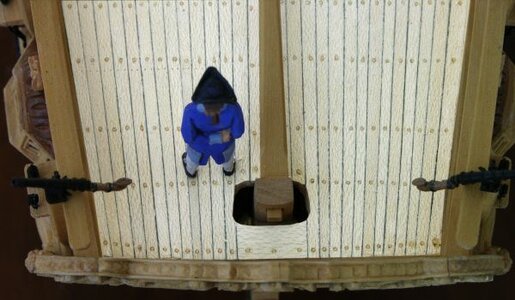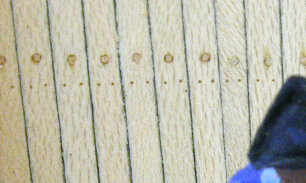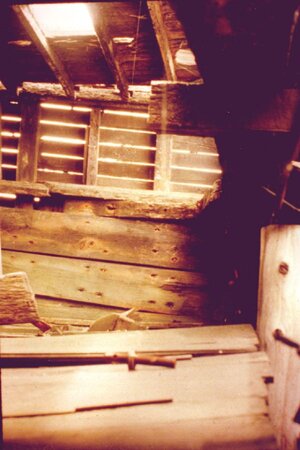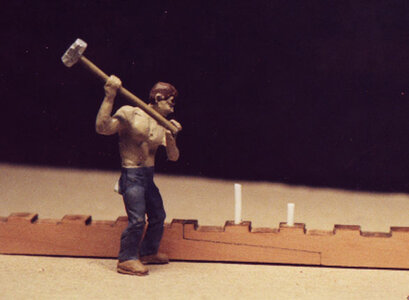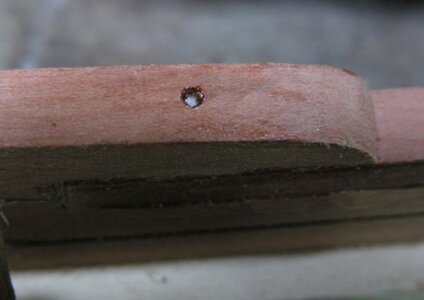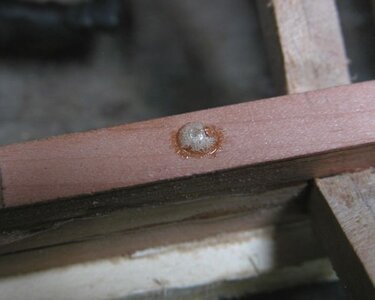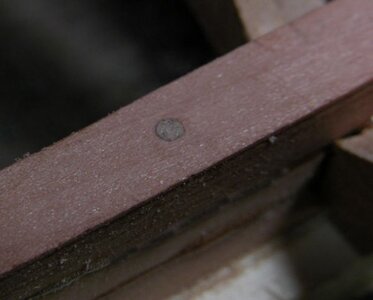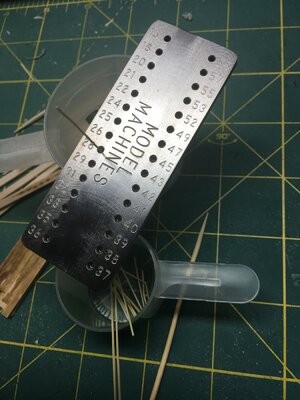I will be getting the Bonhomme Richard deluxe cross section model, as so beautifully done here by Uwe and others, and couldn't find a thread dedicated to tree nails. I search shows a bit about them in several articles, which I've read, but thought I'd ask here about everyone's suggested/best/favorite method.
The BR is in 1/48 scale, which I consider ideal for tree nail details. I didn't bother on my 1/98 scale HMS Victory, but if I had at that scale, they'd be pin pricks. 1/48 scale is entirely different, and I love what I'm seeing on the BR models here as well as the incredible advertising photos they use.
The method's I've read about and am considering include:
On inside (cabin structure) areas, I assume nails would be used rather than tree nails, the greater expense and time required for tree nails not being necessary for non-structural portions of the ship. Is that true? If so, pin/needle pricks, which would stain darker, would seem appropriate for those areas, should anything be used at all.
I had heard that tree nails on ships in the 1760-1850 era generally were plugs to protect an iron or other metal screw or bolt? Is that the case? I think older ships used treenails as attachments themselves, not to cover holes created to use other fasteners.
I have seen tree nails usually made of a contrasting color of wood, if only slightly, than the wood it is inserted into. Although too much contrast might look too much like dots. Interestingly, Wikipedia states about tree nails in ships that "However, when the treenail was a different wood species from the planking, it usually caused rot".
As to visibility of tree nails on on ships, in many pictures of the HMS Victory's decking, notably the top deck, it is very difficult to see any sign of the tree nails, while in other lower deck photos they are clearly visible. It's obvious from these photos that adding tree nails is a modeling thing that we like to see and that indicates a sign of great craftsmanship rather than a realistic representation.
Anyhow, that's what I think I know about tree nails and showing them on models. I'd love to hear ideas on their creating on models, especially on mine in the 1/48 scale range, as to methods and materials. Please feel free to correct any misinformation I have spread, as I am just learning about this feature.
The BR is in 1/48 scale, which I consider ideal for tree nail details. I didn't bother on my 1/98 scale HMS Victory, but if I had at that scale, they'd be pin pricks. 1/48 scale is entirely different, and I love what I'm seeing on the BR models here as well as the incredible advertising photos they use.
The method's I've read about and am considering include:
- Uwe's method of drilling 0.5 mm (0.020") holes, and filling them with wood putty. They look incredible, but looking at the process, there seems to be as much work sanding down each plank as preparing it. I'm a bit concerned some putty may stay in the grain, and, well, while I may try that, they look like too much work for me. One reader suggested putting tape on the planks before drilling and filling, to limit the mess, but I think someone said they had a hard time getting nice accurate holes that way. BTW, Uwe used 0.2mm copper wire, I think, for nails through the beams, and they look good too. Would copper have been used, thought, or would iron be more appropriate?
- Carlosys made an excellent model of the same kit, and apparently just drilled holes, without filling them. In the photos, they look great, and I would never have guessed that they weren't filled. I'm not sure if the holes were drilled through, deep or shallow, but once stained or varnished, that would highlight them nevertheless. This method is very tempting, if it looks as good in person.
- Peter Vought has used the "Schwabian method" of drilling holes and installing toothpicks in them on the keel of his Yuanqing Bluenose, which are then cut off and sanded. TRUE tree nails. But it boggled my mine when I found some other say that each toothpick has to be sharpened first. He experimented with different sizes on this model, and I think ended up with 0.6mm, with 0.7mm in the keel.
- I have also seen a method where a sharp mechanical pencil was used inside a larger-than-necessary round hole template, with the outline of the tree nail "drawn" on the wood. I've tried something similar on another model, and seemed to have trouble with excess pencil lines that required removal and redoing. The result looks pretty accurate, if the tree nails were done with the same wood, and would be easier to do. As long as they don't get marked up, fade out or bleed into the wood on finishing.
- I was wondering myself about the possibility of using a very small carpenter's nail set. They make them down to 1/32" (0.8mm) in size. I tried pounding 3/32" (2.4mm) one into soft wood and it made a nice appearance of a defined ring, with a rounded center area representing the tree nail. Doing the same thing on walnut wasn't as visible. Any stain would tend to darken the ring appearance so that might work out. Something to try out on a scrap of pear once I get the kit.
- Another thought I just had now that might result in something similar to the nail set, but you could use a drill press for, is a piece of tubing with the outside diameter that you want the tree nail to appear as. It could be reamed out slightly with a drill, file or whatever, and maybe even teeth carved into it, so as to cut a small ring.
- Other methods which others have used or thought of.
On inside (cabin structure) areas, I assume nails would be used rather than tree nails, the greater expense and time required for tree nails not being necessary for non-structural portions of the ship. Is that true? If so, pin/needle pricks, which would stain darker, would seem appropriate for those areas, should anything be used at all.
I had heard that tree nails on ships in the 1760-1850 era generally were plugs to protect an iron or other metal screw or bolt? Is that the case? I think older ships used treenails as attachments themselves, not to cover holes created to use other fasteners.
I have seen tree nails usually made of a contrasting color of wood, if only slightly, than the wood it is inserted into. Although too much contrast might look too much like dots. Interestingly, Wikipedia states about tree nails in ships that "However, when the treenail was a different wood species from the planking, it usually caused rot".
As to visibility of tree nails on on ships, in many pictures of the HMS Victory's decking, notably the top deck, it is very difficult to see any sign of the tree nails, while in other lower deck photos they are clearly visible. It's obvious from these photos that adding tree nails is a modeling thing that we like to see and that indicates a sign of great craftsmanship rather than a realistic representation.
Anyhow, that's what I think I know about tree nails and showing them on models. I'd love to hear ideas on their creating on models, especially on mine in the 1/48 scale range, as to methods and materials. Please feel free to correct any misinformation I have spread, as I am just learning about this feature.




